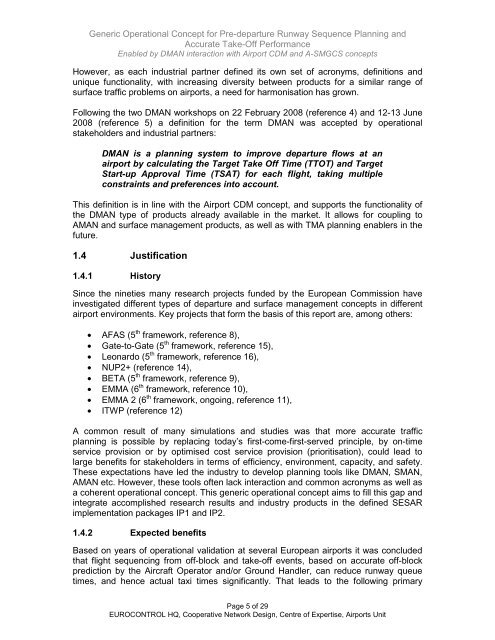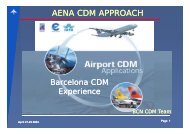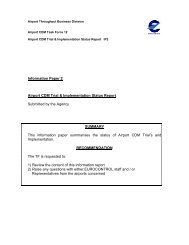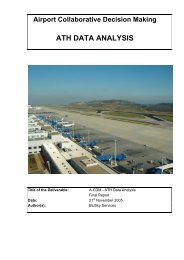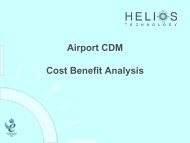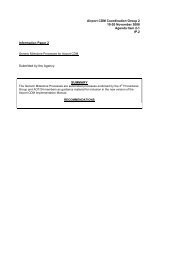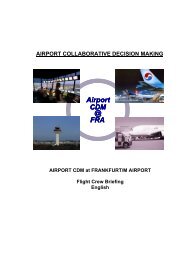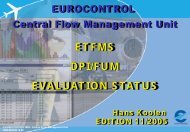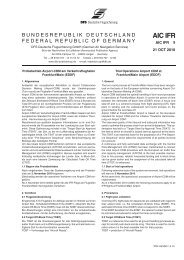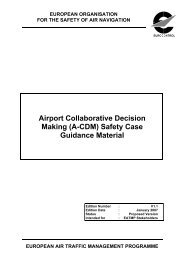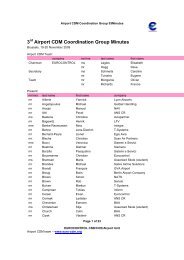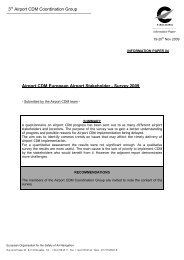Generic Operational Concept for DMAN Interaction v07A - Airport ...
Generic Operational Concept for DMAN Interaction v07A - Airport ...
Generic Operational Concept for DMAN Interaction v07A - Airport ...
You also want an ePaper? Increase the reach of your titles
YUMPU automatically turns print PDFs into web optimized ePapers that Google loves.
<strong>Generic</strong> <strong>Operational</strong> <strong>Concept</strong> <strong>for</strong> Pre-departure Runway Sequence Planning and<br />
Accurate Take-Off Per<strong>for</strong>mance<br />
Enabled by <strong>DMAN</strong> interaction with <strong>Airport</strong> CDM and A-SMGCS concepts<br />
However, as each industrial partner defined its own set of acronyms, definitions and<br />
unique functionality, with increasing diversity between products <strong>for</strong> a similar range of<br />
surface traffic problems on airports, a need <strong>for</strong> harmonisation has grown.<br />
Following the two <strong>DMAN</strong> workshops on 22 February 2008 (reference 4) and 12-13 June<br />
2008 (reference 5) a definition <strong>for</strong> the term <strong>DMAN</strong> was accepted by operational<br />
stakeholders and industrial partners:<br />
<strong>DMAN</strong> is a planning system to improve departure flows at an<br />
airport by calculating the Target Take Off Time (TTOT) and Target<br />
Start-up Approval Time (TSAT) <strong>for</strong> each flight, taking multiple<br />
constraints and preferences into account.<br />
This definition is in line with the <strong>Airport</strong> CDM concept, and supports the functionality of<br />
the <strong>DMAN</strong> type of products already available in the market. It allows <strong>for</strong> coupling to<br />
AMAN and surface management products, as well as with TMA planning enablers in the<br />
future.<br />
1.4 Justification<br />
1.4.1 History<br />
Since the nineties many research projects funded by the European Commission have<br />
investigated different types of departure and surface management concepts in different<br />
airport environments. Key projects that <strong>for</strong>m the basis of this report are, among others:<br />
• AFAS (5 th framework, reference 8),<br />
• Gate-to-Gate (5 th framework, reference 15),<br />
• Leonardo (5 th framework, reference 16),<br />
• NUP2+ (reference 14),<br />
• BETA (5 th framework, reference 9),<br />
• EMMA (6 th framework, reference 10),<br />
• EMMA 2 (6 th framework, ongoing, reference 11),<br />
• ITWP (reference 12)<br />
A common result of many simulations and studies was that more accurate traffic<br />
planning is possible by replacing today’s first-come-first-served principle, by on-time<br />
service provision or by optimised cost service provision (prioritisation), could lead to<br />
large benefits <strong>for</strong> stakeholders in terms of efficiency, environment, capacity, and safety.<br />
These expectations have led the industry to develop planning tools like <strong>DMAN</strong>, SMAN,<br />
AMAN etc. However, these tools often lack interaction and common acronyms as well as<br />
a coherent operational concept. This generic operational concept aims to fill this gap and<br />
integrate accomplished research results and industry products in the defined SESAR<br />
implementation packages IP1 and IP2.<br />
1.4.2 Expected benefits<br />
Based on years of operational validation at several European airports it was concluded<br />
that flight sequencing from off-block and take-off events, based on accurate off-block<br />
prediction by the Aircraft Operator and/or Ground Handler, can reduce runway queue<br />
times, and hence actual taxi times significantly. That leads to the following primary<br />
Page 5 of 29<br />
EUROCONTROL HQ, Cooperative Network Design, Centre of Expertise, <strong>Airport</strong>s Unit


